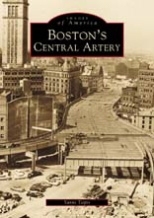Two dirty little words from the 1950s -- Central Artery -- were replaced with two dirty little words in the 1990s -- Big Dig. Now, while Bostonians battle with the serious inconvenience of digging a hole large enough to bury a freeway, we could use a reminder why.
Boston's Central Artery (Arcadia, 2001), a pictorial history written by undergraduate Yanni Tsipis, provides it. The photographs of pre-Central Artery Boston show the downtown area flowing seamlessly into a bustling North End. And like a bit of cold water in the face, these photos wake you right up. Why are we spending a fortune to dig that hole? We're correcting the mistakes of our fathers.
For people who weren't in Boston to watch it happen, Mr. Tsipis's book brings home the true cost of building the Central Artery.
"By the mid-1970s -- barely 15 years after being opened to traffic -- plans were already being formulated to rid the city of the elevated expressway. Today, the city is in the midst of its most complex engineering endeavor, a project that will put the elevated portion of the Central Artery underground and reknit the fabric of the city," wrote Mr. Tsipis in the book's introduction.
"The Central Artery was a product of its time. This was the way engineers and politicians solved problems then: with big plans and very little consideration for the built environment or the natural environment," said the 22-year-old Mr. Tsipis in an interview. "It was an economic consideration. They put the interests of the downtown business community and suburban commuters before the interests of the downtown residents themselves. And this was the result -- catastrophe."
Mr. Tsipis, a senior who's double-majoring in civil and environmental engineering and urban studies and planning, wasn't here to see Boston before the Central Artery. By the time he was born in 1979, plans had already been drawn for ridding the city of the monstrous green structure. Maybe that's what sparked his interest in the history of the city.
"I grew up in Brookline and history was my favorite subject since grade school," he said. But the city's history, especially its architecture and infrastructure, is his main passion.
"From age zero, he has declared that he will never leave Boston (which delights his parents) and that he's going to change Boston," said his father, Professor Kosta Tsipis, a retired faculty member in physics who is now a research scientist in the Department of Mechanical Engineering.
Yanni Tsipis got the idea for the book project while working on a class assignment, a political history of the Massachusetts Turnpike extension of the early 1960s. While researching that project in the state transportation library, he found the Central Artery photos. Last spring he decided to prepare the pictorial history and pitched the idea to Arcadia publishers for its series, Images of America. Once he had approval, Mr. Tsipis completed his research, collected his photos and spent a couple of weeks in Maine putting the book together.
"Every summer we go to Mt. Desert Island," said Professor Tsipis. "Last summer Yanni sat there for 10 days and did most of the work on the book, with incredible discipline. He is the most disciplined child I've ever seen. But he's also a bouncer in a nightclub, over my objections of course," said the bemused father.
Part of Mr. Tsipis's preparations included seeking out key personnel from the Central Artery project. He went to the Barletta Co., the construction firm that built the downtown portion of the project, but found that "the family has a history of heart disease and no one in the family lives past 40. They're on their third generation since the Artery," said Mr. Tsipis. He did find Cranston Rodgers (SM 1951), who was the chief structural engineer for the tunnel section of the original Central Artery. That portion was built underground after people saw the reality of the above-ground freeway. Mr. Rodgers, who now works on the Big Dig, told Mr. Tsipis, "We're making up for our mistake 50 years ago."
Another key resource was MIT's Fred Salvucci, the man often credited with conceiving the idea of putting the Central Artery underground. Mr. Salvucci, a senior lecturer in civil and environmental engineering, was secretary of transportation for Governor Dukakis. That administration planned, designed and financed the project, but didn't get to manage it.
"My first stop was Fred Salvucci," said Mr. Tsipis. "The Big Dig is a miracle -- an engineering and political miracle. It gives something to everyone, or will when it's done."
Mr. Tsipis is working on his next book, a history of transportation in Boston. He also plans to graduate in June.
A version of this article appeared in MIT Tech Talk on March 8, 2001.







